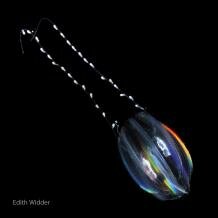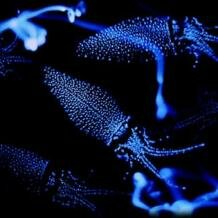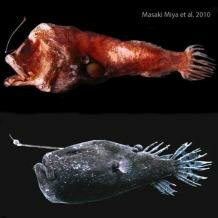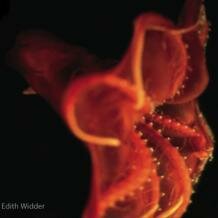Topic: Why emit light? The many functions of bioluminescence
Flying through the air on a summer’s evening or sparkling in the ocean, magical flashes of light signal some of nature’s most enchanting creatures, those that can generate their own light. Bioluminescence, the capacity of an organism to emit cold light by a natural chemical reaction, is an intriguing feature of creatures as diverse as squid, fish, fungi and beetles. Across the tree of life such light production has evolved independently at least 40 times and in reality more likely more than 50 times: here is convergent evolution on a truly impressive scale.
The wide distribution of bioluminescence points both to its critical ecological importance as well as its rampantly convergent evolutionary origins. Glowing species are known from almost all the major animal phyla as well as certain fungi, protists and bacteria. Bioluminescent species predominate in the marine environment, especially at depth and in the open ocean where it provides the main light source. Light is the ideal way to communicate, disappear or hunt in the translucent, stable, and for the most part sunlight-deficient regions of the sea (sunlight reduces 10 times for every 75 metres depth below the surface, with permanent darkness existing below 1000m).
Bioluminescence serves many functions, both in the dark depths of the ocean and on land. Light emission is used as a means of defence, as an aid to hunt effectively or under the cover of darkness even to attract potential mates…
Defensive bioluminescence
 Many marine organisms startle would-be predators with flashing displays, notably in sparkling dinoflagellates, in the vampire squid (Vampyroteuthis) and in sternchaser lanternfish (myctophids), which emit a blinding flash and then dash away. This strategy is also reflected in the cascading colours of certain ctenophores (e.g. Beroe) and jellyfish, and in the general glowing response of many animals when disturbed, ranging from sea pansies (the soft coral Renilla) to syllid fireworms (the polychaeteOdontosyllis).
Many marine organisms startle would-be predators with flashing displays, notably in sparkling dinoflagellates, in the vampire squid (Vampyroteuthis) and in sternchaser lanternfish (myctophids), which emit a blinding flash and then dash away. This strategy is also reflected in the cascading colours of certain ctenophores (e.g. Beroe) and jellyfish, and in the general glowing response of many animals when disturbed, ranging from sea pansies (the soft coral Renilla) to syllid fireworms (the polychaeteOdontosyllis).
It has been reported that some bioluminescent species flash when under threat of predation in order to attract attention from higher order predators, which then swoop in to attack the attacker. This burglar alarm strategy is evidently employed by dinoflagellates being attacked by shrimps, the flashes of which serve to attract predatory fish and squid to tangle with the shrimps.
 Various jellyfish, ctenophores, crustaceans, squid, polychaetes, arrow worms and tube-shoulder fish can discharge a smokescreen of luminous particles or slime, evidently to confuse predators while they make their escape. For example, when disturbed the ostracod Vargula hilgendorfi (aptly known as the sea firefly) ejects a trail of flashing blue light; the copepods Gaussia and Peuromamma do the same; ostracods and oplophorid shrimps (e.g. Acanthephyra, Oplophorus) are known to squirt volumes of luciferin and luciferase from separate mouth tubes, creating disembodied blue clouds some distance from the animal. Coronate jellyfish Atolla and Periphylla produce internal waves of light and also secrete bright particles, while vampire squid release luminous secretions from its arm tips.
Various jellyfish, ctenophores, crustaceans, squid, polychaetes, arrow worms and tube-shoulder fish can discharge a smokescreen of luminous particles or slime, evidently to confuse predators while they make their escape. For example, when disturbed the ostracod Vargula hilgendorfi (aptly known as the sea firefly) ejects a trail of flashing blue light; the copepods Gaussia and Peuromamma do the same; ostracods and oplophorid shrimps (e.g. Acanthephyra, Oplophorus) are known to squirt volumes of luciferin and luciferase from separate mouth tubes, creating disembodied blue clouds some distance from the animal. Coronate jellyfish Atolla and Periphylla produce internal waves of light and also secrete bright particles, while vampire squid release luminous secretions from its arm tips.
In an almost comical manner, a number of species are known to release glowing body parts (termed autotomy) to misdirect the attention of a predator. Well described cases involve the glowing autotomized arms of brittle stars (ophiuroids), tentacles of siphonophore jellyfish and the deep sea squid Octopoteuthis deletron. Other examples include the flashing scales of polynoid scale-worms and the luminous ‘bombs’ released by a deep-sea annelid (Swima bombiviridis). A similar distraction technique is used by the squid Octopoteuthis, which lets its arms fall away from its body when threatened, with decoy light organs flashing at the arms tips.
 Some luminous animals may still defend themselves even after being partly eaten by a predator. How? When chewed-off body parts continue to glow inside the predator cloak of its own invisibility vanishes and so makes it stand out to secondary predators. As for the other defence strategies, this is a convergent feature of many independent taxa, being reported in a pelagic sea cucumber (holothurian) Enypniastes eximia, polychaete annelids and coronate medusa jellyfish. When feeding, copepods also seem to reject flashing dinoflagellates presumably to avoid the unwelcome attention a glowing stomach might otherwise draw. Interestingly, many predators have evolved red or black stomach linings to counter the effects of this so-called sacrificial tag defense strategy.
Some luminous animals may still defend themselves even after being partly eaten by a predator. How? When chewed-off body parts continue to glow inside the predator cloak of its own invisibility vanishes and so makes it stand out to secondary predators. As for the other defence strategies, this is a convergent feature of many independent taxa, being reported in a pelagic sea cucumber (holothurian) Enypniastes eximia, polychaete annelids and coronate medusa jellyfish. When feeding, copepods also seem to reject flashing dinoflagellates presumably to avoid the unwelcome attention a glowing stomach might otherwise draw. Interestingly, many predators have evolved red or black stomach linings to counter the effects of this so-called sacrificial tag defense strategy.
Counterillumination is a form of camouflage commonly found in bioluminescent cephalopods (e.g. the firefly squid Wataseniascintillans), as well as fish and crustaceans. Using ventral photophores (light organs) these animals modify the angle, colour and distribution of light in order to make their silhouettes match the light coming from above. In this way they become almost invisible to predators peering from below. Excellent examples of counterilluminating fish include hatchetfish (e.g. Sternoptyx), myctophid lanternfish (e.g. Myctophus) and juvenile midshipman fish (Porichthys) that remain vulnerable in the water column before, as adults, they finally settle to the sea floor.
 A defence strategy underlying a number of luminous animals is aposematism, where light emission signals toxicity and distastefulness. Aposematic bioluminescence has been proposed, but not proven, for deadly jellyfish, brittle stars (ophiuroids) and polynoid scale worms (polychaetes covered in scales, or elytra). As mentioned above, aposematic signaling is a common explanation for light emission (and bright colouration) in terrestrial animals, most notably in bioluminescent beetles, millipedes and centipedes.
A defence strategy underlying a number of luminous animals is aposematism, where light emission signals toxicity and distastefulness. Aposematic bioluminescence has been proposed, but not proven, for deadly jellyfish, brittle stars (ophiuroids) and polynoid scale worms (polychaetes covered in scales, or elytra). As mentioned above, aposematic signaling is a common explanation for light emission (and bright colouration) in terrestrial animals, most notably in bioluminescent beetles, millipedes and centipedes.
Offensive bioluminescence
 Some sinister deep-sea fish, cephalopods and even cnidarians cleverly attract prey using a glowing lure. Perhaps best known are the anglerfish (e.g. Bufoceratias), which have a blub-like culture of bioluminescent bacteria dangling at the end of a long lure (or esc). Most dragonfish (stomiids), such as Borostomias and Photostomias, have lure-like barbels, while the squidChiroteuthis has glowing lures dangling from the ends of its tentacles. Certain octopus (e.g. Stauroteuthis) tempt prey to within their reach using luminescent suckers, swimming with their arms extended to form an alluring glowing web. The siphonophore jellyfish Erenna employ flickering lures on their hanging tentacles, strategically located adjacent to deadly stinging cells.
Some sinister deep-sea fish, cephalopods and even cnidarians cleverly attract prey using a glowing lure. Perhaps best known are the anglerfish (e.g. Bufoceratias), which have a blub-like culture of bioluminescent bacteria dangling at the end of a long lure (or esc). Most dragonfish (stomiids), such as Borostomias and Photostomias, have lure-like barbels, while the squidChiroteuthis has glowing lures dangling from the ends of its tentacles. Certain octopus (e.g. Stauroteuthis) tempt prey to within their reach using luminescent suckers, swimming with their arms extended to form an alluring glowing web. The siphonophore jellyfish Erenna employ flickering lures on their hanging tentacles, strategically located adjacent to deadly stinging cells.
 A number of deep-sea fish have remarkable anterior light organs that seem to function like headlights when searching the depths for prey. The aptly named stop light dragonfish (or loosejaw) Malacosteus is a prime example. It has sub-orbital photophores that emit red light and, in combination with a blue-green sensitive feedback system (this is because the fish cannot itself perceive red light), this allows it to detect prey that is insensitive to red light. Aristostomias and Pachystomias(which belong to the same family as Malacosteus) and the closely related stomiidTactostoma possess similar red photophores. Certain flashlight fish, such asPhotoblepharon, have bright post-orbital photophores that whilst bacterial in origin and emitting a blue-green light have also been implicated in illuminating the environment in the hunt for food. In the same way the lanternfish Diaphus may also rely partly on its own emitted light to detect its prey of copepods.
A number of deep-sea fish have remarkable anterior light organs that seem to function like headlights when searching the depths for prey. The aptly named stop light dragonfish (or loosejaw) Malacosteus is a prime example. It has sub-orbital photophores that emit red light and, in combination with a blue-green sensitive feedback system (this is because the fish cannot itself perceive red light), this allows it to detect prey that is insensitive to red light. Aristostomias and Pachystomias(which belong to the same family as Malacosteus) and the closely related stomiidTactostoma possess similar red photophores. Certain flashlight fish, such asPhotoblepharon, have bright post-orbital photophores that whilst bacterial in origin and emitting a blue-green light have also been implicated in illuminating the environment in the hunt for food. In the same way the lanternfish Diaphus may also rely partly on its own emitted light to detect its prey of copepods.
As a twist to the tale of defensive counterilluminators, cookiecutter dogfish sharks (Isistius brasiliensis) use offensive counterillumination. Their whole shadow is camouflaged, blending into the colour of overlying seawater via ventral photophores, save for a dark band at its throat/gill slits that mimics the shape of a small fish and hence attracts large predators such as tuna, which the shark then attaches to and takes a bite out of.
Certain predators seem to use bright flashes offensively rather than defensively, confusing or stunning prey while they attack. Good evidence for this comes from the squidTaningia danae that, when attacking bait, flashes wildly from large light organs at the tips of its hook-bearing arms.
Intraspecific communication
 Bioluminescent organisms frequently broadcast light signals to identify one another and attract potential mates. Sexual dimorphism is often accompanied with sex-specific light emission patterns, underlining the link in many species between bioluminescence and sexual selection. Light emission by the bioluminescent squid Watasenia and octopus Japetella has been recorded at atypical wavelengths. This suggests that these, and most likely other organisms, employ the equivalent of a ‘private channel’ which is used for species-specific communication.
Bioluminescent organisms frequently broadcast light signals to identify one another and attract potential mates. Sexual dimorphism is often accompanied with sex-specific light emission patterns, underlining the link in many species between bioluminescence and sexual selection. Light emission by the bioluminescent squid Watasenia and octopus Japetella has been recorded at atypical wavelengths. This suggests that these, and most likely other organisms, employ the equivalent of a ‘private channel’ which is used for species-specific communication.
On land, insects such as fireflies emit light for mate recognition and attraction. In the sea the minute ostracods have received attention for the way they use light signals to communicate with potential mates. Complex mate-following behaviour has been observed, with most males directing lavish light displays at females whilst a few sneaky males hover close by and given the opportunity lazily benefit from the others’ efforts.
Multifunctional bioluminescence
Luminosity frequently serves multiple functions, for lights in the darkness cannot help but attract curious prey as much as conspecifics. For example the characteristic glowing lures of anglerfish and dragonfish may attract mates as well as prey. In lanternfish (e.g. Diaphus, Myctophum), species and sex-specific photophore patterns have been linked not only to courtship signals but also to shoaling behavior and counterillumination. Once again this list could continue almost indefinitely, showing that in this realm as in all other areas of bioluminescence convergence is rife.
Cite this web page
Map of Life - "Why emit light? The many functions of bioluminescence"
https://mapoflife.org/topics/topic_594_why-emit-light-the-many-functions-of-bioluminescence/
March 3, 2021

